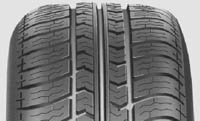|
Компания "Шина-ДВ" - Продажа автошин в Хабаровске на avtoshina-dv.ru! |
 |
 |
|

The world's first rubber tire was made by the Englishman Robert William Thomson. Patent No. 10990, dated June 10, 1846, says: “The essence of my invention consists in the use of elastic bearing surfaces around the rims of the wheels of carriages in order to reduce the force necessary to pull carriages, thereby facilitating movement and reducing noise, which they create when they move.” Thomson's patent is written to a very high standard. It outlines the design of the invention, as well as the materials recommended for its manufacture. The tire is superimposed on a wheel with wooden spokes inserted into a wooden lunch, upholstered in a metal hoop. The tire itself consisted of two parts: the tube and the outer cover. The chamber was made of several layers of canvas impregnated and coated on both sides with natural rubber or gutta-percha in the form of a solution. The outer covering consisted of pieces of leather connected by rivets. Thomson equipped the crew with air wheels and conducted tests by measuring the crew's thrust. Tests have shown a reduction in traction force of 38% on crushed stone pavement and 68% on crushed pebble pavement. Noiselessness, ride comfort and easy running of the carriage on new wheels were especially noted. The test results were published in the Mechanics Magazine on March 27, 1849, along with a drawing of the carriage. It could be stated that a great invention had appeared: thought out to a constructive implementation, proven by tests, ready for improvement. Unfortunately, that's where it ended. There was no one who took up this idea and brought it to mass production at an acceptable cost. After Thomson's death in 1873
 Technology Center
More than £63 million has been invested in Nissan's European Technology Centers in Belgium, Spain and the UK. The European Technology Center in Cranfield, UK is located at the heart of European automotive parts, ensuring close communication and synergy with its many European suppliers. In some areas, such as car security (anti-theft technology), Cranfield has become Nissan's global research center.
Engineers from Brussels are involved in all stages of Nissan projects in Europe related to the development and development of vehicles.
Kursänderung für die Produktion von Autos
Das Geld, das Sakishi aus dem Verkauf der Patentrechte an seinen automatischen Webstühlen erhielt, wurde anschließend dem jungen Kiishiro gegeben. Der Vater vermachte seinem Sohn, das Geschäft nicht nur weiterzuführen, sondern es auch in ein Unternehmen zur Herstellung von Autos umzuwandeln. Sakishi glaubte fest daran, dass die Menschen vor vielen Jahren ohne Autos nicht leben könnten. Leider unterstützten nicht viele seine Idee. Das hielt Kiishiro jedoch nicht davon ab, den Erlös aus dem Verkauf des Patents zu verwenden, um sich mit „fremden“ Autos einzudecken, sie für Ersatzteile zu zerlegen und die Automobilindustrie zu studieren.
Technology Center
More than £63 million has been invested in Nissan's European Technology Centers in Belgium, Spain and the UK. The European Technology Center in Cranfield, UK is located at the heart of European automotive parts, ensuring close communication and synergy with its many European suppliers. In some areas, such as car security (anti-theft technology), Cranfield has become Nissan's global research center.
Engineers from Brussels are involved in all stages of Nissan projects in Europe related to the development and development of vehicles.
Kursänderung für die Produktion von Autos
Das Geld, das Sakishi aus dem Verkauf der Patentrechte an seinen automatischen Webstühlen erhielt, wurde anschließend dem jungen Kiishiro gegeben. Der Vater vermachte seinem Sohn, das Geschäft nicht nur weiterzuführen, sondern es auch in ein Unternehmen zur Herstellung von Autos umzuwandeln. Sakishi glaubte fest daran, dass die Menschen vor vielen Jahren ohne Autos nicht leben könnten. Leider unterstützten nicht viele seine Idee. Das hielt Kiishiro jedoch nicht davon ab, den Erlös aus dem Verkauf des Patents zu verwenden, um sich mit „fremden“ Autos einzudecken, sie für Ersatzteile zu zerlegen und die Automobilindustrie zu studieren.
|
|